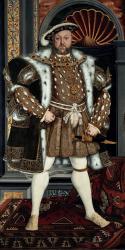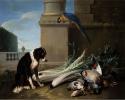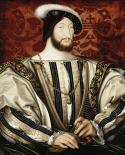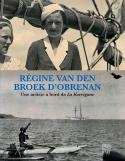Art Of The Day Weekly
#380 - from 19 March 2015 to 25 March 2015
IN THE AIR
Bonnard vs terrorism
PARIS – How to mention it? It is certainly legitimate to honour the victims of the terrorist attack at the Bardo Museum in Tunis. Yet, this media coverage, and the following feeling of despair and fear, are precisely what the perpetrators are looking for. It is not the first time that the Western democracies liberty of information and free speech are double-edged weapons… Against these blind and bloody attacks, why not seek a kind of spiritual consolation in Bonnard? His sunny gardens, his Mediterranean lights are miles away from people that seem to stick to Millán Astray's motto for his Spanish Legion, “¡Viva la muerte!“ The current exhibit at Orsay is focused on Bonnard's ‘secret garden’: his interiors, in particular the bathroom, which is a universe all to itself, the balcony and the dining-room, which he knows how to transform into a decorative symphony. A table corner with a few reliefs, a window open on to a tree, a corridor with two doors, striped wall paper and a bathtub all become universal themes vibrant with color. While the three large decorative panels commissioned by Russian collector Morosov, brought all the way from Saint-Petersburg, majestically close the exhibit, the visitor is impressed in particular by other loans: the Femmes au chien from the Clark Art Institute, Salle à manger à la campagne from the Minneapolis Institute of Arts or Jeunes Femmes au jardin from a private collection: so many trophies come from afar and rarely brought together. Images of an impossible dream : a world finally at peace.
• Pierre Bonnard, peindre l’Arcadie at the musée d’Orsay, from 17 March to 19 July 2015.
EXHIBITIONS

Henry VIII, after Hans Holbein the Younger, 1540-1550, 238,3 x 122,1 cm, oil on panel, © West Sussex, Petworth House, National Trust.
Tudor, an intensive course
PARIS – “When you see me you know me”, as Samuel Rowley wrote in a play at the beginning of the XVIIth century, referring to Henry VIII (1509-1547). When we run into the monarch in the exhibition, when we are face to face with the colossal figure, as tall as a mountain, covered with ermine, with a metallic look, one easily imagines how he disquieted those who met him. The painting that is 2.38 m tall is derived from a painting by Hans Holbein the Younger, who was an extraordinary public relations agent. His official images have printed forever in our sub-conscience the mighty power of the English Blue Beard. And his delicate ink drawings have perpetuated other faces –like that of the child king Edward VI or Mary Tudor, “Bloody Mary”. The exhibition, mounted with the National Portrait Gallery, brings back to life the domestic intrigues and his policy of grandeur which made them as famous as the Borgia and Napoleon. This is an opportunity to see works that rarely leave London, in particular the oil paintings on wood by Master John or Guillim Scrots, with an extraordinary documentary precision in which the lace, rugs and pearls offer a deceiving framework to the rugedness of the characters.
• Les Tudors at the musée du Luxembourg, from 18 March to 19 July 2015.
The other great king
PARIS – A sheer coincidence, Francis I, the alter ego of Henry VIII, is being celebrated in great style. The moment is obvious: the fifth centennial of Marignan, one of the most important dates in French history. The exhibition is not limited to a battle in Lombardy (tourists will never find souvenirs in the present Melegnano, near Pavia, where the battle took place in September) but it does draw the portrait of a sovereign (1515-1547) who is credited with introducing the Renaissance into France, but who had his more somber aspects– in particular the repression of the reformed religion. The stage producer of the royal image, here the mirror of Holbein, is Jean Clouet. The exhibit shows, around the recently acquired illuminated manuscript Douze Césars, the image of a knight King and an educated king, a great fighter, a friend of poets and a sponsor of Leonardo da Vinci.
• François Ier, pouvoir et image, at the Bibliothèque nationale de France, from 24 March to 21 June 2015.
These exhibitions are also opening
Travelling in the year 1000
FLORENCE – To celebrate its 150th anniversary, the museum of Bargello, set up in the former palace of the ‘Capitano del popolo’, built in the XIIIth century, tries to bring the medieval era back to life Age. Based on its very rich collections as well as on its partnerships with other medieval museums in Europe, it focuses on a time that is full of mystery through the filter of travels–pilgrimages, business travels, war travels. Weapons, bills of exchange, relics, shoes and bags are all material proof of the constant travels of our ancestors.
• Il Medioevo in viaggio at the museo del Bargello, from 20 March to 21 June 2015.
Altdorfer, a taste for the fantastic
VIENNA – On the one hand, Dürer and his rational and realistic vision of the world. On the other, another side of the Northern Renaissance, influenced by the world of fantasy and imagination. The exhibition is embodied first and foremost by Albrecht Altdorfer, one of the landscape pioneers of the XVIth century. The exhibit also brings together among the nearly 140 pieces exhibited, the enigmatic Master IP, or Wolf Huber.
• Realms of imagination, at the Kunsthistorisches Museum, from 17 March to 14 June 2015.
AUCTIONS

François Desportes, Chien devant un trophée de chasse. Signed and dated at bottom right Desportes / 1724 Oil on canvas, 121 x 155 cm. Estimate: 300.000-400.000 €. © Sotheby's Art Digital Studio.
The spirit of the XVIIIth century
PARIS – It is customary to say that the XVIIIth French century is no longer well looked upon, in particular as regards furniture. In painting, the major names such as Watteau, and a few specific domains such as still lives escape this temporary observation. This sale which will scatter a family collection enriched by the current owner, includes examples of great value, in particular a series of François Desportes, one of the favorite painters of Louis XV in his older age before the introduction of Oudry, and a richly decked, almost poisonous platter, of grenades, grapes and figs by Largillierre. Two beautiful works by Louyse Moillon, one of the rare female painters of the previous century, are the link with the Spanish masters of the bodegones. But the main item of this sale could end up being a seascape by Joseph Vernet, considered a national monument, le Lever du jour. It is estimated between €400 000 €600 000: in the world of contemporary art this would be a trifle.
• Collection Louis Grandchamp des Raux at Sotheby’s, in collaboration with Artcurial, on 26 March 2015.
ARTIST OF THE WEEK
Naumann is back in Paris
Is he a videoartist? A conceptual artist? A minimalist artist? It is difficult to put a label on the work of Bruce Nauman. And the retrospective presented by the Fondation Cartier, the first of this scope in France in the last fifteen years, will not help lift the doubts. The artist was born in 1941 in Indiana but went to live a long time ago to New-Mexico. Here we ‘see’ his sound piece, For Children (2015), inspired very indirectly by Béla Bartók, then a gigantic video of balanced, coloring pencils (Pencil Lift/Mr Rogers, de 2013) before the visitor is invited to travel through time downstairs in the basement. That is where the artist’s memory expresses itself with three older installations, of which a couple of dancers drawing the hands of a powerful clock or this Carrousel, which makes its stock of dead animals turn. All are thoughts on the passage of time, on our fragile humanity, on our senses or on the most banal daily life.
• Bruce Nauman is shown at the Fondation Cartier, from 14 March to 21 June 2015.
BOOKS
1934, the adventure of the Korrigane
A handful of aristocrats embarked for a world tour on a refurbished cod fishing boat, right after the events of February 1934. They most probably did not know they were about to write one of the last chapters of ethnographic exploration in the Pacific Ocean. Retrospectively the long voyage on the Korrigane (1934-1936) produced a wonderful lot of objects before the war and legislation made this sort of adventure. The last survivor of the group, Régine van den Broek d’Obrenan (née de Ganay, and related to the Schneider dynasty and to former French first lady Anne-Aymone Giscard d’Estaing) died at the age of 106 in 2014. In this story written by 2 authors -including the drawings - she recalls the adventures of this sail: when the crew almost drowned along the coast of New-Zealand, was the prey of real-false cannibals oe when they swiped artefacts from the locals. These elements from the poupe of the pirogue, this skull relic holder in the shape of a shark, these feather currencies, the cups from the islands of Admiralty are now part of the treasures at the museum of quai Branly.
• Régine van den Broek d’Obrenan, une artiste à bord de la Korrigane, by Christian Coiffier, Somogy, 2014, 300 p., €35.
IN BRIEF
PARIS - The 24th Salon du Dessin (fair of drawings) will be held from 25 to 30 March 2015.
PARIS - Drawing Now, the fair of contemporary drawing, will be held from 25 to 29 March 2015.
ROUEN - The Historial Jeanne d'Arc, dedicated to one of the main characters in the history of France, will open on 21 March 2015.




